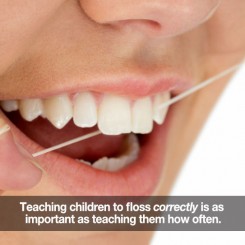
NEGLECTING TO FLOSS can lead to all kinds of oral health problems—including tooth decay and periodontal disease. As parents, you play the major role in making sure your children are flossing daily, but you also need to help them floss correctly. The correct and incorrect techniques associated with flossing are not complicated, but they can make all the difference in your child’s oral health.
Help Your Child Tighten Up Those Flossing Skills!
Help your child understand…
- Don’t skip a day now and then. Floss daily to remove harmful bacteria.
- Don’t “saw back and forth” which could cut into your gums. Slide the floss up and down against the tooth’s surface.
- Don’t floss too aggressively. Snapping the floss into your gums can cut them and damage the tissue.
- Don’t forget to floss under your gum line to remove hard-to-reach plaque.
- Don’t forget to floss the back side of those very, very back teeth (even though they’re not up against another tooth).
Important Flossing Tips:
- Start with about 18 inches of floss. Wind most around one finger and the rest around the same finger on the opposite hand.
- Be gentle! Slide the floss between your teeth and below the gums and then use a soft up-and-down rubbing motion.
- Use a new section of your floss for each tooth to avoid spreading bacteria from tooth to tooth.
- Flossing in front of a mirror can help you be more thorough.
- You can floss in the morning or at night, before or after you brush.
Young Children Need Assistance
Flossing is an important part of your child’s daily oral health routine. However, maximizing the benefit comes from doing it correctly. That’s where you come in. Until he or she is old enough, your child will need your help and supervision.
Have Questions About Flossing?
If you have additional questions about flossing or any other aspect of your oral hygiene, please contact us. We’d love to hear from you! And you can always post questions directly on our Facebook page.
